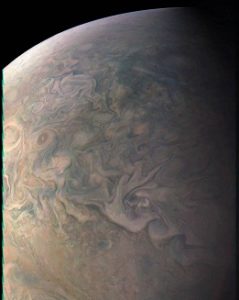
NASA has a released a new image of Jupiter captured on Dec 11, 2016 by JunoCam imager on NASA’s Juno spacecraft. The image has been processed by citizen scientists Gerald Eichstaedt and John Rogers. The caption of the image was also drafted by them.
NASA posts JunoCam’s raw images at www.missionjuno.swri.edu/junocam to allow the public to peruse them and process into image products.
The new image offers an amazing view of the high north temperate latitudes and a giant storm known as a Little Red Spot. This storm appears as reddish oval on the planet when seen by Earth-based observers. This storm was first tracked about 23 years ago. The Little Red spot appears as pale brown smudge in the center, and is difficult to see as the color of the spot blends with the surroundings clouds.
Jupiter is the largest planet in our solar system and appears to astronomers as a deep red orb surrounded by layers of orange, pale yellow, and white. Jupiter’s Great Red Spot is actually a massive, spinning storm – more than twice Earth’s size – in the atmosphere of the planet. The maximum speed of winds inside the storm sometimes reaches about 270 miles per hour.
Juno is a NASA space probe launched from Cape Canaveral on August 5, 2011, with an aim to study planet Jupiter. Juno was built by Lockheed Martin as part of NASA’s New Frontiers program to study Jupiter’s composition, magnetic field, gravity field, and polar magnetosphere. It is operated by NASA’s Jet Propulsion Laboratory. Juno entered a polar orbit of Jupiter on July 5, 2016. The mission life of Juno is 20 months, and during this period, Juno will try to find clues about the formation of Jupiter, the amount of water present within the deep atmosphere, mass distribution, its core composition, and its deep winds. After completion of the mission, the spacecraft will be deorbited into Jupiter’s atmosphere.
Juno is the second spacecraft, after Galileo, to orbit Jupiter. The nuclear powered Galileo spacecraft orbited around Jupiter from 1995 to 2003. Juno uses its solar arrays to get power to operate. Juno has three largest solar array wings ever deployed on a planetary probe, which generate power for Juno and also help in stabilize it.
